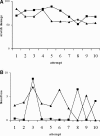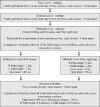An evidence-based virtual reality training program for novice laparoscopic surgeons
- PMID: 16858196
- PMCID: PMC1602164
- DOI: 10.1097/01.sla.0000218094.92650.44
An evidence-based virtual reality training program for novice laparoscopic surgeons
Abstract
Objective: To develop an evidence-based virtual reality laparoscopic training curriculum for novice laparoscopic surgeons to achieve a proficient level of skill prior to participating in live cases.
Summary background data: Technical skills for laparoscopic surgery must be acquired within a competency-based curriculum that begins in the surgical skills laboratory. Implementation of this program necessitates the definition of the validity, learning curves and proficiency criteria on the training tool.
Methods: The study recruited 40 surgeons, classified into experienced (performed >100 laparoscopic cholecystectomies) or novice groups (<10 laparoscopic cholecystectomies). Ten novices and 10 experienced surgeons were tested on basic tasks, and 11 novices and 9 experienced surgeons on a procedural module for dissection of Calot triangle. Performance of the 2 groups was assessed using time, error, and economy of movement parameters.
Results: All basic tasks demonstrated construct validity (Mann-Whitney U test, P < 0.05), and learning curves for novices plateaued at a median of 7 repetitions (Friedman's test, P < 0.05). Expert surgeons demonstrated a learning rate at a median of 2 repetitions (P < 0.05). Performance on the dissection module demonstrated significant differences between experts and novices (P < 0.002); learning curves for novice subjects plateaued at the fourth repetition (P < 0.05). Expert benchmark criteria were defined for validated parameters on each task.
Conclusion: A competency-based training curriculum for novice laparoscopic surgeons has been defined. This can serve to ensure that junior trainees have acquired prerequisite levels of skill prior to entering the operating room, and put them directly into practice.
Figures





Similar articles
-
A Virtual Reality Training Curriculum for Laparoscopic Colorectal Surgery.J Surg Educ. 2016 Nov-Dec;73(6):932-941. doi: 10.1016/j.jsurg.2016.05.012. Epub 2016 Jun 21. J Surg Educ. 2016. PMID: 27342755 Clinical Trial.
-
Development of a virtual reality training curriculum for laparoscopic cholecystectomy.Br J Surg. 2009 Sep;96(9):1086-93. doi: 10.1002/bjs.6679. Br J Surg. 2009. PMID: 19672934
-
Learning curves and impact of previous operative experience on performance on a virtual reality simulator to test laparoscopic surgical skills.Am J Surg. 2003 Feb;185(2):146-9. doi: 10.1016/s0002-9610(02)01213-8. Am J Surg. 2003. PMID: 12559445
-
Take-Home Training in Laparoscopy.Dan Med J. 2017 Apr;64(4):B5335. Dan Med J. 2017. PMID: 28385174 Review.
-
Virtual reality simulators and training in laparoscopic surgery.Int J Surg. 2015 Jan;13:60-64. doi: 10.1016/j.ijsu.2014.11.014. Epub 2014 Nov 18. Int J Surg. 2015. PMID: 25463761 Review.
Cited by
-
Call-associated acute fatigue in surgical residents--subjective perception or objective fact? A cross-sectional observational study to examine the influence of fatigue on surgical performance.World J Surg. 2013 May;37(5):1176-7. doi: 10.1007/s00268-013-1911-2. World J Surg. 2013. PMID: 23397167 No abstract available.
-
Comprehensive training curricula for minimally invasive surgery.J Grad Med Educ. 2011 Sep;3(3):293-8. doi: 10.4300/JGME-D-11-00091.1. J Grad Med Educ. 2011. PMID: 22942951 Free PMC article.
-
The new ACS/APDS Skills Curriculum: moving the learning curve out of the operating room.J Gastrointest Surg. 2008 Feb;12(2):213-21. doi: 10.1007/s11605-007-0357-y. Epub 2007 Oct 10. J Gastrointest Surg. 2008. PMID: 17926105
-
Perceptual impairment and psychomotor control in virtual laparoscopic surgery.Surg Endosc. 2011 Jul;25(7):2268-74. doi: 10.1007/s00464-010-1546-4. Epub 2011 Feb 27. Surg Endosc. 2011. PMID: 21359902 Free PMC article.
-
Do soft skills predict surgical performance?: a single-center randomized controlled trial evaluating predictors of skill acquisition in virtual reality laparoscopy.World J Surg. 2011 Mar;35(3):480-6. doi: 10.1007/s00268-010-0933-2. World J Surg. 2011. PMID: 21190109 Clinical Trial.
References
-
- Aggarwal R, Moorthy K, Darzi A. Laparoscopic skills training and assessment. Br J Surg. 2004;91:1549–1558. - PubMed
-
- Gallagher AG, Cates CU. Virtual reality training for the operating room and cardiac catheterisation laboratory. Lancet. 2004;364:1538–1540. - PubMed
-
- Satava RM. Accomplishments and challenges of surgical simulation. Surg Endosc. 2001;15:232–241. - PubMed
-
- Grantcharov TP, et al. Randomized clinical trial of virtual reality simulation for laparoscopic skills training. Br J Surg. 2004;91:146–150. - PubMed
MeSH terms
LinkOut - more resources
Full Text Sources

